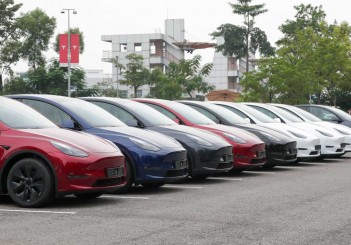A Continetal tyre made from dandelion rubber.
Dutch biologist Ingrid van der Meer often meets with disbelief when she talks about her work on dandelions and how it could secure the future of road transport.
The reaction is understandable, given most people regard the yellow flowers as pesky intruders in their gardens rather than a promising source of rubber for tyres.
“People just think of it as a horrible weed and ask how can you get enough material for tyres from just a small root,” she said.
Her research team is competing with others across the world to breed a type of dandelion native to Kazakhstan whose taproot yields a milky fluid with tyre-grade rubber particles in it.
Global tyre makers such as industry leader Bridgestone Corp and No. 4 player Continental AG believe they are in for rich pickings and are backing such research to the tune of millions of dollars.
Early signs are good. A small-scale trial by a US research team found that dandelions delivered per hectare rubber yields on par with the best rubber tree plantations in tropical Asia.
So within a decade, rather than being a backyard bane like their wild cousins, the new flowers might be seen in neat rows in hundreds of thousands of acres across Europe and the United States, where they can grow even in poor soil.
And they could have some interesting modifications. For instance, German researchers have bred the plants to grow to up to 30 cm in height, dwarfing many of their backyard cousins. They are also developing the dandelions with upright rather than flat-growing leaves – just so harvesting machines have something to grab on to.
The tyre industry, which consumes about two-thirds of the world’s natural rubber, has long felt uneasy about its complete reliance on rubber tree tapping in a handful of South-East Asian nations which account for most of the US$25bil in annual natural rubber output.
More than 100 years since the invention of synthetic rubber from petrochemicals, global road and air traffic still depends on the unique properties of plant-based rubber – which to date cannot be replicated by the man-made material.
Passenger car tyres need to have 10%-40% natural rubber content to allow them to stay flexible at low temperatures and to keep tiny cracks from growing. Truck and aircraft tyres need an even higher percentage.
Tyre makers’ worst fear is that an uncontrollable fungus that has choked all attempts to run plantations in Brazil – where the rubber tree originates – might one day wreak havoc in South-East Asia.
The volatility of the rubber market has added urgency to the search for alternative crops. Rubber prices surged to a record high of more than US$6 per kg in early 2011 – when weather-related supply shortages in South-East Asia coincided with strong demand growth and speculative rubber traders betting on further gains.
But prices slumped to multi-year lows of US$2 this year on expectations of slowing economic growth in China, the world’s largest rubber market.
Any impact on prices would have huge implications for tyre firms. Natural rubber accounted for about a third of raw material costs at the world’s second largest tyre maker Michelin last year, for example, and almost a quarter at smaller peer Pirelli, said analysts at Credit Suisse.

Another concern about the current market is that rubber-supplying countries, led by Thailand and Indonesia, will not have the acreage to keep up with long-term growth in tyre demand.
Credit Suisse analysts put demand growth rates at close to 4% annually over the next four years.
Tyre makers took a lesson from history in the search for a homegrown feedstock.
When trade with Asia collapsed during War II, the Kazakh dandelion, also called Russian dandelion, was cultivated in the United States, Europe and Soviet Union for an emergency supply of rubber despite meagre yields.
After the war, however, trade links were restored and companies returned to the more cost-efficient Asian plantations.
It has only been in recent years that dandelions have been re-examined, given the fungus fears and price volatility and also advances in bio-engineering that many believe have made the flowers an economically viable source of rubber.
The rediscovery began around 2007, when a team of researchers at Ohio State University started exploring dandelion and guayule, a desert shrub native to the southwest United States and Mexico. They were joined by Bridgestone and Cooper Tire in a project called PENRA.
An European Union-backed rubber initiative based in the Netherlands followed suit in 2008 and van der Meer’s follow-up project has India’s Apollo Tyres Ltd and Czech tractor tyre maker Mitas a.s. as commercial partners. There is also a German group supported by Continental AG.

At the end of the seven-year US programme in 2020, Katrina Cornish, the Ohio team’s research director, says her team aims to have drawn up a detailed business plan and beginners’ guide for future dandelion farmers, complete with instructions on how to fertilise, irrigate and harvest.
In a small plot trial, her team says it has achieved what would be annual per hectare yields of more than 1,500kg of rubber with just the second generation of dandelions, on a level with the best Asian tree plantations.
But that was under ideal conditions and has yet to be replicated on a farm-size scale. Her team is now in the process of harvesting eight acres of new dandelions planted last year.
In Germany, lead researcher Dirk Pruefer with the university of Muenster and state-backed research institute Fraunhofer, says the breeders with his project had achieved yields of up to 500kg per hectare in the open field and are pushing for 1,000kg.
Pruefer says calculations have shown that with the targeted yield of about 1,000kg, land the size of Austria would be required to meet the entire global demand for natural rubber just from dandelions.
But far from hoping that the rubber tree can be replaced, tyre makers would be happy with even a complementary source.










